IN THIS ISSUE
- Raven nest a rarity
- Lewis Island giants
- Cicadas and copperheads
- Blues brooding in odd places
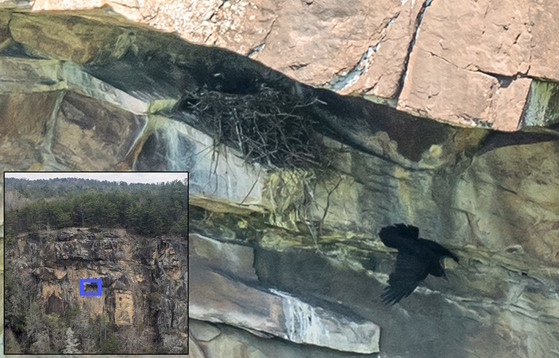 A raven leaves the nest; inset: nest site on the gorge wall (Austin Suhr/DNR; inset: Liz Morata/DNR)
Consider this your best chance to see ravens nesting in Georgia.
Two of the big, black birds – ravens are the largest member of the crow family – are raising young on a cliff at Tallulah Gorge State Park. Park Manager Lieren Merz said staff will be putting up signage at the overlook with the best view. The cliff section has been temporarily closed to rock climbing to avoid disturbing the ravens.
Although the species’ name is common raven, these birds are far from common in Georgia. Ravens are seen only in high elevations in the state’s northeastern corner. Their nests rate even rarer.
Over the last 15 to 20 years, nesting has been confirmed in the state at Brasstown Bald and, from 2021 through 2023, on Nottely Lake dam near Blairsville (Georgia’s first known raven nest built on something other than a cliff ledge), according to DNR Program Manager Dr. Bob Sargent.
Sargent did see a newly fledged raven at Tallulah Gorge in 2021 but didn’t find a nest. That honor fell to fellow employee Liz Morata. This March, while searching the gorge near Tallulah Falls for signs of peregrine falcons nesting (DNR has checked annually since peregrines nested there in 2015), the GIS specialist spotted two ravens at a nest tucked under a massive overhang.
During a follow-up visit in late April, Morata and Sargent saw two nestlings about 3 weeks old. Given their age, Sargent expects the young to fledge, or leave the nest, the second or third week of this month.
Meanwhile, Merz said bird walks at the park this spring will highlight the ravens.
 Common raven, an uncommon bird (Adobe Stock)
IF YOU GO
- ParkPass required
- Binoculars help, but a spotting scope is best for viewing the nest
- Check the park website and Facebook page for planned bird walks. (Note: weekends at the park are busy. Staff may limit access if parking is full.)
ABOUT COMMON RAVENS
-
Looks: Sooty black with long, heavy bill. Up to 2 feet long with a 4-foot wingspan (a third larger than American crows, state’s most common crow).
-
Call: Hoarse croaks (listen)
-
Range: Found across Northern Hemisphere but limited in Georgia to high elevations in extreme north. Over last 100-150 years, range and numbers in eastern U.S. were reduced by habitat loss, shooting, trapping and poisoning. Breeding Bird Survey data from 1966-2019 shows population increasing.
-
Nesting: Builds stick nests up to 5 feet wide and 2 feet deep, usually on rock ledges
-
Smarts: One of the more intelligent birds; works to solve problems and exhibits play behaviors, including sliding in snow. For more: “Ravens parallel great apes in physical, social cognitive skills.”
-
Aerobatic: Agile flyers known for stunts including rolls, somersaults, even flying upside down
-
Iconic: Associated with loss, omens and prophecy (including the Tower of London’s fall). Referenced in the Bible, Quran, Jewish folklore, Norse mythology and Bob Dylan lyrics.
– Bob Sargent, Rick Lavender
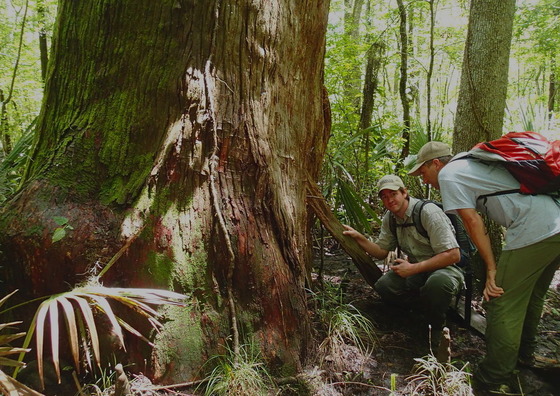 Jason Lee, right, former DNR biologist Jacob Thompson and a big bald cypress on Lewis Island (Carolyn Davis/NPS)
Jason Lee likes to think the Altamaha River had a hand in sparing Georgia’s largest known virgin stand of tidal-swamp bald cypress and water tupelo trees.
The theory is a flood waylaid logging on Lewis Island in the early 1900s. The 5 to 10 acres of ancient trees that hadn’t been cut offered too little profit for crews to return. A rusting cable engine that once dragged downed trees to water sits abandoned on Lewis, giving credence to Lee’s conjecture.
“So that’s what saved that tiny bit of old growth on freshwater tidal swamplands on our coast,” he said, adding with a chuckle: “The Altamaha said, ‘Let’s keep this stand.’”
Whatever the reason, the DNR Wildlife Conservation Section program manager is one of many who are grateful the site was saved. The state has owned and managed the 5,600-acre island about 3 miles upriver from Darien since 1972, the first acquisition of the Georgia Heritage Trust.
This month also marks the 50th anniversary of Lewis Island’s designation as a National Natural Landmark in 1974. The National Park Service program recognizes and encourages conservation of lands that best illustrate the nation’s biological and geological heritage, according to Carolyn Davis, Southeast Region coordinator.
This Altamaha River island certainly fits. ...
See DNR's blog about Lewis Island, its "stand of giants" and golden anniversary.
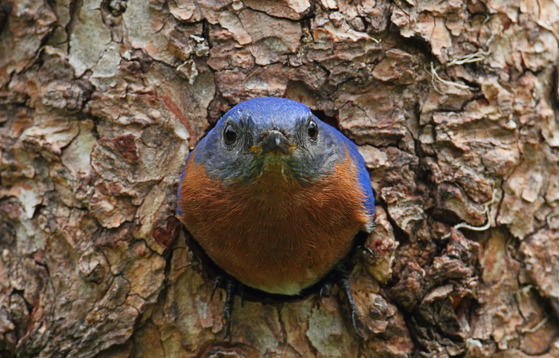 Bluebird in an "old-school" nest – a tree cavity – unlike the strange nest sites some choose (Adobe Stock)
By TERRY W. JOHNSON
When the first European colonists set foot in North America, the eastern bluebird was nesting almost exclusively in cavities found in native trees. However, as the population of these early settlers swelled and began to dramatically change the environment, bluebirds began nesting in places that were previously unavailable.
Some of these sites continue to be downright strange.
From bluebirds nesting in a railroad signal ball in the 1800s – which raised and lowered scores of times daily – to birds in more recent times raising their young in newspaper delivery tubes and the tailpipes of junked cars, this species has a penchant for picking some odd nest sites. …
Read Terry’s column for more on unusual bluebird nests.
Terry W. Johnson is a retired DNR manager and executive director of TERN, friends group of the Wildlife Conservation Section. Check out past columns and his blog. Permission is required to reprint a column.
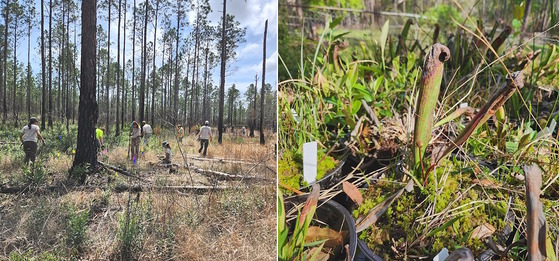 Biologists and volunteers plant rescued pitcherplants in a restored Alapaha WMA wetland (DNR)
Nearly 300 hooded pitcherplants rescued from a road construction site near Valdosta last fall have been rehomed at Alapaha River Wildlife Management Area. The team effort involving the Georgia Native Plant Society’s Coastal Plain Chapter, DNR and the state Department of Transportation had been in the works for more than a year. The hooded pitcherplants moved to the WMA near Ocilla also weren’t the only beneficiaries: Other key plants – including butterworts and hatpins – and even sphagnum mosses that protect soil moisture for the pitcherplants were moved.
Reduce risks to birds by regularly cleaning your feeders and feeding areas. Diseases such as conjunctivitis and avian pox can flourish and spread at neglected feeders, says DNR wildlife biologist Todd Schneider, who offered these tips for healthier feeding stations.
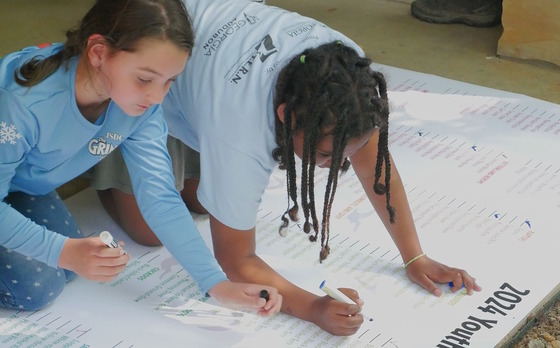 Youth Birding Competition team members mark species on a contestwide checklist (Ethan Hatchett/DNR)
More than 100 young birders flocked to the 18th annual Georgia Youth Birding Competition last month, with teams counting a combined 189 species statewide. Coordinator Tim Keyes, a DNR wildlife biologist, cited new first-year teams in every age division, one team raising over $1,000 for conservation and an overall winner – DeKalb County's Wood Thrushes – reporting an eye-opening 159 species.
When a visit to a Jenkins County conservation easement revealed that neighboring cattle had worn a path in the floodplain, DNR alerted the site’s owner and found where the cows were crossing onto her property. This just one example of how the annual monitoring required for DNR-held easements helps conserve habitats and wildlife and forge relationships between landowners and agency staff. Landowner programs.
 Gopher frogs, one of 640 species of conservation concern in Georgia's Wildlife Action Plan (Dirk J. Stevenson)
President Biden’s funding request for State Wildlife and Tribal Grants in fiscal year 2025 is 2 percent more than last year and matches funding for fiscal 2023. State Wildlife Grants is the only federal program designed to prevent wildlife from becoming endangered, yet the nearly $74 million proposed for all states and tribes in 2025 (Georgia received $1.5 million in 2023) is a far cry from the some $26 million each state needs to conserve key species identified in their State Wildlife Action Plans.
The second nesting attempt also ended badly for bald eagles livestreamed at Berry College. B17, the eaglet hatched as part of a second clutch laid after the pair’s first two eggs collapsed, died overnight on April 11, the school reported.
 Bradford pear blooming on UGA's Griffin campus (UGA Extension)
Quick hits:
- Callery pear, also known as Bradford pear (one of its varieties), is an Asian tree that is invasive in the eastern U.S. and widely known across Georgia for its white spring blooms, foul odor and spike-like thorns. Native alternatives.
- Check out these 12 statewide winners chosen from nearly 3,500 entries in the 34th annual Give Wildlife a Chance Poster Contest.
- For bird banding dates and times at the longtime Panola Mountain State Park station, email coordinator Charlie Muise, who says all – including novices – are welcome but it helps if he knows who’s coming.
- Upcoming prescribed fire events include a Seasonality of Burning Workshop for private landowners May 22 in Midville and the Georgia Prescribed Fire Council north Georgia meeting June 13 in Jasper.
- While reviewing research to create online profiles of Georgia’s native earthworms, DNR data technician Amaad Blades documented several species, including Carolina mudworm, not confirmed in the state before.
- White shrimp are not only the backbone of Georgia’s commercial shrimping, they are the state crustacean, according to a bill Gov. Brian Kemp signed last week.
- The latest Coastal Georgia Ecosystem Report Card gives the health of coastal ecosystems a B, “a moderately good score,” says DNR’s Coastal Resources Division, which compiles the annual assessment.
 State Botanical Garden's Will Rogers discusses pitcherplants with Joan Mooney of the Interior Department (UGA)
Names in the news: The Interior Department’s Joan Mooney visited the State Botanical Garden of Georgia last month to highlight the collaborative Georgia Native Seed Network, an effort to supply genetically appropriate seed and plants for habitat restoration and wildlife recovery in the Southeast. The work promoted by Mooney, principal deputy assistant secretary for policy, management and budget at Interior, involves the UGA garden in Athens, the U.S. Fish and Wildlife Service, the Southeastern Grassland Institute, DNR and the U.S. Department of Agriculture. Dr. Bob Sargent of DNR’s Wildlife Conservation Section co-authored the recent publication of a study in Landscape Ecology that identifies and explores key breeding habitats for the threatened eastern North American population of golden eagles. Senior ranger Jason Webb of Richard B. Russell State Park near Elberton has been named DNR State Parks and Historic Sites Division’s Ranger of the Year.
WHAT YOU MISSED ...
In the previous Georgia Wild:
- iNaturalist data wanted
- Treetop buffet for birds
- Another right whale dead
- DNR chief's wildland legacy
"Invasive lizard species threatens native wildlife in Georgia," WSB-TV (Atlanta), and others including Georgia Sun, Georgia Public Broadcasting
(+video) "DNR shares do's and don'ts of snake season," WALB-TV (Albany)
(+audio) "Boaters asked to watch for manatees, sea turtles," GPB
"‘Mega-rare’ bird seen in Oregon is first sighting in U.S. history," KOIN-TV (Portland, Ore.)
"Ag department needs public help spotting invasive hornets," WTGS-TV (Hardeeville, S.C.)
(+video) "A look at rare, endangered plants in the U.S.," CBS News
"Right whale calving season ends with 19 born; 1 dead, 4 presumed dead, WJAX-TV (Jacksonville, Fla.). Related: "Whale entangled off New England in devastating year for vanishing species," The Associated Press; (+video) "Cargo ship monitor Whale Safe heads east to help endangered whales," University of California
"Youth Birding Competition celebrates 'another great year,'" Clayton Daily News and others
"Making buildings safe for birds," The Atlanta Journal-Constitution
"Help keep invasive species out of Georgia waters," The Albany Herald
"Gentrification brings more wildlife to urban areas," The Wildlife Society (study: Proceedings of the National Academy of Sciences)
"Statewide winners in Give Wildlife a Chance Poster Contest," AllonGeorgia
Tugboat added to Reef DRH off Little St. Simons, DNR Coastal Resources Division
(video) "People try to pull bear cubs from trees in N.C.," NPR. Related: N.C. wildlife agency response.
"New video shows right whale mother, calf in Cape Cod Bay," CBS News
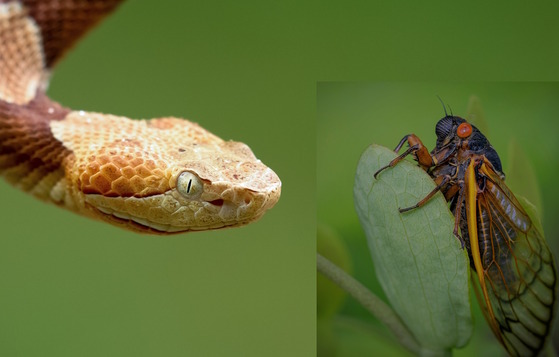 A copperhead-cicada connection? Not so much. (Adobe Stock)
With periodical cicadas emerging at a remarkable rate this year, some Georgians are concerned about copperheads. This may seem an odd connection at first glance, but the venomous snakes are known to eat the big-and-loud insects. So, will the emergence of brood XIX after almost 13 years underground draw scores of copperheads to an area? Not exactly, says DNR senior wildlife biologist Daniel Sollenberger. While copperheads prey opportunistically on cicadas and other invertebrates, periodical cicadas aren’t the only cicadas emerging this year. Cicadas emerge every year. And every year they’re eaten by snakes, birds and other wildlife. While this year will be buzzing with cicadas, it likely won’t affect copperhead numbers or distribution.
- Ethan Hatchett
|